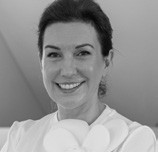ASK THE EXPERTS
Our beauty experts answer your questions about every aspect of running a salon or spa business
1 How do I master make-up application on
menopausal clients?
Navigating make-up through the menopause can throw a few challenges our way. The techniques and products clients have previously used seem to stop working due to hormonal changes that can significantly impact the skin. Here are a few things to consider for menopausal make-up application:
• Skincare: If your client is complaining about the way make-up looks on their skin, suggest an in-salon facial and skin analysis. Here, the professional therapists can tailor-make a regime for their skin’s specific needs.
• Primer: A good primer will smooth the appearance of fine lines, wrinkles, uneven skin texture and open pores.
• Foundation: Choose a lightweight hydrating foundation or tinted moisturiser infused with skincare ingredients. This will even out the appearance of the skin, giving a light, fresh, dewy coverage, combatting the signs of dry or dull-looking skin.
• Under-eye brightener: Use a light-reflecting and hydrating formula for under the eyes to combat puffiness and dark circles. Choose a fine, serum-like texture that won’t settle into fine lines.
• Concealer: For blemishes, dark spots and severe redness that is visible after foundation, I would recommend a matte concealer. Use a small brush or sponge to apply sparingly.
• Mascara: As we get older, our lashes become sparser, so go for a volumising mascara to thicken their appearance.
• Brows: With age, these can become thinner, and sometimes patchy. I like to use a tinted brow gel to cover greys and comb strays into place, and then a fine-tipped pencil to mimic hairs and fill in gaps.
• Lips: Our lips become thinner and less plump in menopause so use a natural lip liner slightly above and below the upper and lower bow of the lip to enhance shape and size. Liner will also help prevent feathering.
• Hydrating spray: This will lock in moisture, while adding a fresh, dewy finish. This is particularly beneficial if the client is experiencing hot flushes throughout the day.

Sarah-Jane Froom is a professional make-up artist, TV presenter and content creator, with over 26 years’ experience in the beauty and fashion industry.
2 What is the best way to create a signature treatment?
In an industry where countless professionals offer similar services, standing out is not just about keeping up with trends, it’s about finding what makes you unique, and creating experiences that reflect your values.
One way to do this is by developing a signature treatment – an offering that not only highlights your skills and passion, but also deeply resonates with clients, providing them with an unforgettable experience.
From a business perspective, a signature treatment allows you to offer a service that commands a premium price, as clients are often willing to invest more in a unique and exclusive service that they cannot get anywhere else.
Start by reflecting on what inspires you as a therapist. What do you want your business to stand for? What techniques, products or philosophies are you passionate about? These elements should form the foundation of your unique signature treatment. For example, use products that you love and that deliver noticeable results, making your treatment effective and desirable.
Next, think about the dream client you wish to attract. What results are they looking for? What standout experience can you master that will have them lining up to book with you, rather than the salon down the road?
Select brands and modalities that align with your vision and the results you wish to achieve. Incorporate advanced techniques that showcase your expertise, whether that is a specialised massage, an innovative layering method or a unique sensory experience. Build flexibility into your signature treatment, so the protocol can be tailored.
Finally, embrace the process of refining your signature treatment. Listen to client feedback, trust your intuition and allow your treatment to evolve. This continuous improvement will keep your signature treatment fresh, relevant, and deeply connected to you and your clients.

Joanne Serrant is an advanced facialist and the owner of The Skin&Soul Academy and Joanne Serrant Advanced Skincare in the UK.
3 How can I adapt my facial massage
technique for different clients?
Facial massage is beneficial for all age groups, and it can be customised to address specific age-related concerns, adapting to clients’ needs in each stage of life. We can consider the unique challenges faced by different age groups, and have a look at some of the differentiations.
Clients aged 20 to 30
For younger clients, the primary focus of facial massage can be on lymphatic drainage and detoxification. At this age, the skin is still relatively firm and elastic, but urban living, pollution and daily environmental stressors can contribute to a build-up of congestion and dullness. Combinations of enzyme peeling and regular facial massage that includes manual lymphatic drainage (MLD) are beneficial for detoxifying the skin and removing waste products.
Clients aged 30 to 45
For this age group, the concerns often shift towards managing the impact of stress, busy lifestyles and the early signs of ageing. Massage techniques like myofascial and muscle release can be particularly effective in relieving tension, improving circulation and enhancing oxygen flow. This holistic approach can reduce stress, promote mindfulness and support mental clarity.
Clients aged 45 and beyond
In this stage of life, clients’ concerns are often focused on addressing sagging skin, loss of definition and reduced skin density. The skin is supported by a complex scaffolding of muscles, bones, subcutaneous fat and other structures. My approach targets these deeper structures through advanced techniques that involve working on the facial muscles, fascia and even the skeletal alignment. This creates a more profound lifting effect, improving overall facial contours and firmness.

Anna Tsankova is a skin expert and educator, and a world champion in face massage, who has worked with a number of professional and premium spa brands, including Swissline.
4 What is the difference between inflamed skin and a stripped acid mantle?
Modern lifestyles have led to us consuming toxic particles all day. And when we are stressed, we create toxins in our body, compromising our immune system. Over time, this creates inflammation in the body, which is its protective response to try to remove harmful stimuli and begin the healing process.
The skin will always reflect what’s happening internally, and this inflammation eventually manifests on the skin as small, inflamed bumps that look like a slight rash, with papules and pustules appearing along the lower cheek area.
A stripped acid mantle can present as multiple skin conditions showing on the face, such as dryness and sensitivity on the cheeks, an excessively oily t-zone and breakouts on the perioral area. Many practitioners will know the cause well – overuse of products and/or incorrect products for the skin type being used, which lead to the pH of the skin being changed.
Inflammation means that the body cannot effectively create the acid mantle on the skin to protect and maintain hydration, leading to the skin becoming sensitive and reactive. This will be observed on both inflamed skin and impaired barriers.
Treating inflamed skin requires a different approach to a stripped acid mantle. When combating a stripped acid mantle, you need to repair the pH of the skin by cutting down on or changing the products that the client is using. Aloe vera is amazing for repairing the pH of the skin quickly, but if we use this treatment method for inflamed skin, the skin will calm down temporarily, but the inflammation will continue.
So, what’s the best approach? Firstly, identify the condition by carrying out an in-depth skin consultation. This, paired with educating the client about inflammation, will help them to make the necessary lifestyle changes.
In terms of homecare, the aim is to protect the skin from the outside through gentle products. I would also suggest referring clients to a nutritionist to ensure they are effectively treating the skin condition internally as well as externally.

Annalouise Kenny is the founder and chief executive of Skin Philosophy, which has training centres for skin education and advanced treatment techniques across Ireland and the UK.